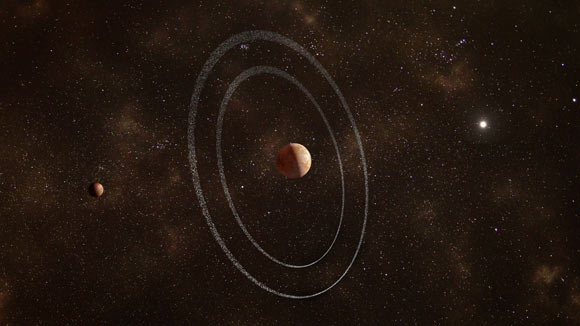The newly-discovered moon has an estimated diameter of 38 km (23.6 miles) and a V magnitude of 28, likely making it the faintest satellite ever found around a trans-Neptunian object.

This image of Quaoar and its moon Weywot was captured by the NASA/ESA Hubble Space Telescope on February 14, 2006. Image credit: NASA / ESA / Hubble / Michael E. Brown.
Discovered on June 4, 2002, Quaoar is a trans-Neptunian object about 1,100 km (690 miles) in diameter.
Like the dwarf planet Pluto, this object dwells in the Kuiper Belt, an icy debris field of comet-like bodies.
Also known as 2002 LM60, it orbits at 45.1-45.6 astronomical units (AU) from the Sun and has an orbital period of 284.5 years.
In 2006, astronomers discovered Quaoar’s satellite, Weywot, that has a diameter of 80 km (50 miles) and orbits at 24 Quaoar radii.
More recently, they detected two rings around Quaoar, named Q1R and Q2R.
“In the past decade, stellar occultations have revealed the presence of rings around small bodies,” said Florida Space Institute astronomer Benjamin Proudfoot and his colleagues.
“Among these small body ring systems, the rings around Quaoar are perhaps the most mysterious.”
“The two rings so-far discovered are well-outside the Roche limit and are inhomogeneous.”
“Quaoar’s outer ring — named Q1R — appears to be at least partially confined by mean motion resonances with Quaoar’s moon Weywot, as well as spin-orbit resonances with Quaoar’s triaxial shape.”
“The inner ring — Q2R — is seemingly less dense and its confinement is more uncertain.”
“Recently, during a stellar occultation, simultaneous dropouts from two telescopes revealed the presence of a previously undiscovered satellite or dense ring around Quaoar.”
“The duration of the dropout implied a minimum diameter/width of 30 km.”

An artist’s impression of Quaoar and its two rings. Quaoar’s moon Weywot is shown on the left. Image credit: ESA / Sci.News.
In their new study, the astronomers aimed to characterize the orbit of this new satellite candidate.
They found that the object is likely on a 3.6-day orbit, placing it near a 5:3 mean motion resonance with Quaoar’s outermost known ring.
They also examined the possibility of observing the satellite with further stellar occultations.
“Quaoar is favorably placed in the Scutum Star Cloud for another 10 years, providing the best opportunities for occultations during its 286 year orbit,” they said.
“Current ground- and space-based telescopes will struggle to detect the newly-discovered satellite due to both its faintness (9-10 mag fainter than Quaoar) and small angular separation from Quaoar.”
“Our examination of the Webb/NIRCam images of the Quaoar system show no compelling detection of the satellite,” they noted.
“Direct imaging with current facilities will require considerable investment of telescope time to blindly reacquire the phase of the satellite, if it is indeed detectable.”
“Future generation telescopes, however, will likely be able to easily observe it.”
According to the team, the discovery of the new satellite provides evidence that Quaoar’s rings around may have been part of an initially broad collisional disk that has evolved considerably since its formation.
“Examining the formation and history of the moon-disk system will provide a detailed view into the formation of trans-Neptunian objects,” the researchers said.
“We encourage sophisticated tidal, hydrodynamical, and collisional modeling of the Quaoar system.”
The team’s paper has been submitted for publication in the Astrophysical Journal Letters.
_____
Benjamin Proudfoot et al. 2025. Orbital characterization of a newly discovered small satellite around Quaoar. ApJL, in press; arXiv: 2511.07370







